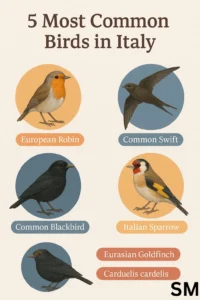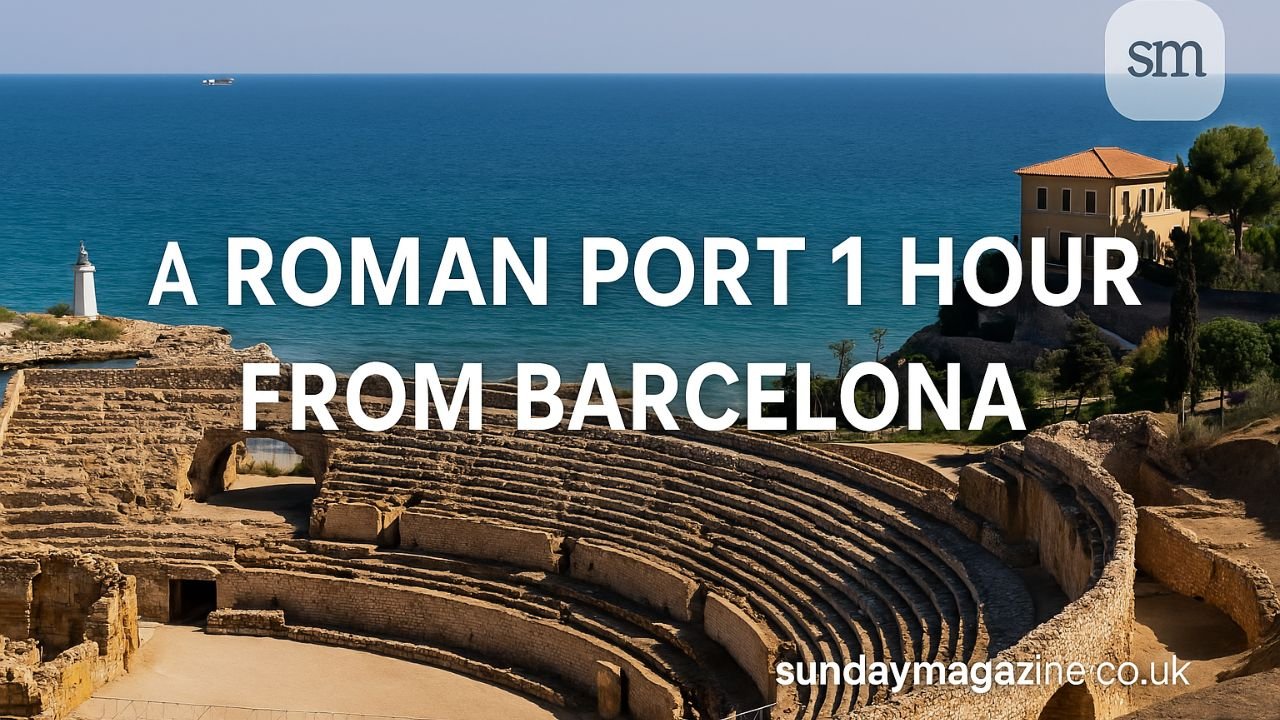Italy, known for its breathtaking landscapes, historic cities, and rich culture, is also a treasure trove for bird enthusiasts. With its diverse climates—from alpine mountains to Mediterranean coastlines—Italy offers a habitat for a vast range of bird species. Whether you are a tourist, a birdwatcher, or simply someone who appreciates nature, understanding the most common birds in Italy can enhance your outdoor experiences dramatically.
Birds are not just beautiful creatures; they are essential to ecosystems. They control pests, pollinate plants, and even help seed dispersal. Learning about the most common birds in Italy connects you with the country’s natural heritage, improves conservation awareness, and enriches any trip through Italian cities, countryside, or coastal areas.
In this article, we’ll explore the 5 most common birds in Italy, offering insights into their habits, identification tips, and even ways you can enjoy spotting them yourself.
ALSO READ: Discover a Roman Port 1 Hour from Barcelona – A Place Worth to Visit!
Understanding the Most Common Birds in Italy
Italy hosts over 500 species of birds, but a handful are especially prevalent throughout the regions. Here’s an in-depth look at the five most common birds in Italy:

1. European Robin (Erithacus rubecula)
- Appearance: Recognizable by its orange-red breast and face, with a brown back and wings.
- Habitat: Gardens, woodlands, parks, and hedgerows.
- Behavior: Friendly and bold, robins often follow gardeners to snatch up unearthed worms.
- Best Places to Spot: Everywhere—from urban centers like Rome to rural Tuscany.
The European Robin is often considered Italy’s unofficial feathered mascot, especially during the colder months.
2. Italian Sparrow (Passer italiae)
- Appearance: A small bird with chestnut-brown head, white cheeks, and black bib.
- Habitat: Urban areas, towns, farmland.
- Behavior: Highly sociable, often seen in flocks chirping loudly.
- Best Places to Spot: Cities like Milan, Florence, and Venice.
Interestingly, the Italian Sparrow is endemic to Italy—meaning it naturally occurs nowhere else!
3. Common Blackbird (Turdus merula)
- Appearance: Males are all black with a bright orange-yellow beak and eye-ring; females are dark brown.
- Habitat: Woodlands, parks, gardens.
- Behavior: Melodious singers, especially during dawn and dusk.
- Best Places to Spot: Countryside estates, olive groves, and suburban gardens.
Their enchanting songs often fill the Italian air during spring and early summer.
4. Common Swift (Apus apus)
- Appearance: Sooty-brown all over, with long, scythe-shaped wings.
- Habitat: Above towns, cities, and open fields.
- Behavior: Aerial acrobats, swifts rarely land except to nest.
- Best Places to Spot: Soaring over cities like Bologna and Florence during summer.
Swifts are incredible migrants, spending the non-breeding season in Africa before returning to Italy.
5. Hooded Crow (Corvus cornix)
- Appearance: Grey body with black head, wings, and tail.
- Habitat: Urban areas, agricultural land, open woodlands.
- Behavior: Intelligent and adaptable; known for scavenging.
- Best Places to Spot: Rome, Sicily, and across northern Italy.
The Hooded Crow is not only smart but culturally significant, often appearing in Italian folklore.
6. European Goldfinch (Carduelis carduelis)
- Appearance: Striking red face with black and white head; golden-yellow wing flashes.
- Habitat: Gardens, orchards, parks, and open countryside.
- Behavior: Lively and gregarious, often heard before seen due to their melodious calls.
- Best Places to Spot: Vineyards in Tuscany, rural Sicily, and Puglia.
In Renaissance art, goldfinches symbolized protection and healing.
7. Eurasian Magpie (Pica pica)
- Appearance: Black and white plumage with a metallic blue-green gloss.
- Habitat: Open countryside, farmlands, suburban areas.
- Behavior: Extremely intelligent; known for collecting shiny objects.
- Best Places to Spot: Piedmont, Lombardy, and Veneto.
Magpies are associated with both luck and superstition across Italy.
Why You Should Learn About Common Italian Birds
Understanding the most common birds in Italy offers benefits such as:
- Enhancing Your Travel: Birdwatching adds depth to sightseeing, especially in scenic regions like Tuscany and Umbria.
- Contributing to Citizen Science: Reporting bird sightings helps ornithological research and conservation efforts.
- Eco-Tourism: Birdwatching tours support local communities and promote sustainable travel.
- Educational Opportunities: Families, schools, and universities use birding to teach biology, ecology, and environmental stewardship.
How to Start Birdwatching in Italy
Interested in spotting these birds yourself? Here’s how:
Get the Right Equipment
- Binoculars: Essential for seeing distant birds clearly.
- Field Guide: Carry a bird identification book or app focused on European or Italian birds.
- Notebook: Jot down what you see; date, location, behavior.
Choose the Right Locations
- Urban Parks: Rome’s Villa Borghese or Milan’s Parco Sempione.
- Countryside: Vineyards, olive groves, and farms.
- Wetlands: Po Delta and Maremma National Park.
Go at the Right Time
- Early Morning: Birds are most active and vocal.
- Migration Seasons: Spring and autumn offer the most diverse sightings.
Practice Patience and Silence
Birds are easily startled. Move slowly, be quiet, and wear neutral-colored clothing.
Step 5: Record and Respect
Respect nature. Never disturb nests, and always follow local conservation guidelines.
Common Problems and Misconceptions About Birdwatching in Italy
- Myth: “You can only see birds in remote nature reserves.”
- Reality: Cities and towns are excellent birdwatching spots.
- Problem: Misidentifying species.
- Solution: Use multiple features—size, color, sound—for accurate ID.
- Challenge: Language barriers when joining local bird tours.
- Tip: Choose international or English-speaking bird guides.
Comparing Italy’s Common Birds with Other European Birds
Compared to northern European countries:
- Italy’s birds are generally more colorful and diverse year-round because of the milder climate.
- Migratory species like Common Swifts are abundant in Italy but rarer in Scandinavia.
- Urban birds such as the Italian Sparrow differ subtly but importantly from their northern counterparts like the House Sparrow.
Pro Tips and Future Trends in Birdwatching in Italy
- Pro Tip: Visit bird migration hotspots like the Strait of Messina to see spectacular migratory events.
- Trend: Eco-tourism companies are increasingly offering customized birdwatching tours.
- Expert Insight: Climate change is shifting bird populations; southern Italy is seeing new species arrive from Africa.
Final Thoughts
Learning about the most common birds in Italy is not just a pastime—it’s an enriching experience that deepens your connection with Italy’s natural and cultural beauty. Whether you’re spotting a cheerful robin in a Roman piazza or marveling at a goldfinch’s colors in a Tuscan vineyard, birdwatching offers a magical perspective on Italian life.
Next time you’re strolling through an Italian town or countryside, look up—you just might spot one of these remarkable feathered locals!
Frequently Asked Questions (FAQ) About the Most Common Birds in Italy
Q1: Can I go birdwatching in Italy without special permits?
A1: Yes! Most parks and public spaces allow free birdwatching. Some reserves may require a small entry fee.
Q2: What is the best season for birdwatching in Italy?
A2: Spring (April-May) and autumn (September-October) are peak migration times and offer the best sightings.
Q3: Are there any endangered birds I might see in Italy?
A3: While this article focuses on common birds, species like the Lesser Kestrel and Ferruginous Duck are endangered and can sometimes be spotted.
Q4: Is birdwatching family-friendly?
A4: Absolutely! Birdwatching can be a fun and educational activity for all ages.
Q5: What Italian regions are best for birdwatching holidays?
A5: Tuscany, Umbria, Veneto, and Sicily offer excellent habitats and bird diversity.
ALSO READ: Zillow Rental Manager – A Tool for Property Management





